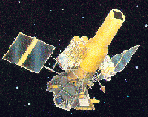|
|

Granat
Granat was launched on 1 December 1989 aboard a Russian PROTON rocket. It was
placed in a highly eccentric 96 hour orbit with an initial apogee of 200,000 km
and a perigee of 2000 km. Over time the orbit circularized so that by 1991
the perigee had increased to 20,000 km. Three days of the four day orbit were
devoted to observations. After an initial period of pointed observations,
Granat was placed in survey mode in September 1994, when the attitude
control gas was exhausted. Granat ceased transmissions on 27 November 1998.
With seven different instruments onboard, Granat was designed to observe the
Universe at energies ranging from X-ray to Gamma-Ray. Specific instruments
were meant to study Gamma-Ray bursts and other transient X-Ray sources while
others were intended to image X-Ray sources near the Galactic Center. One
instrument (WATCH) was designed to monitor the sky continuously and alert the
other instruments to new or interesting X-Ray sources.
The SIMGA telescope was a collaboration between CESR (Toulouse), CEA (Saclay),
and IKI (Moscow). It covered the energy range 30-1300 keV with an effective
area of 800 cm2 and a maximum sensitivity field of view of ~5°
x5°. The maximum angular resolution was 10 arcmin. Its imaging
capabilities were derived from the association of a coded mask and a position
sensitive detector based on the Anger camera principle.
The ART-P and ART-S instruments were both the responsibility of the IKI
in Moscow. The ART-P instrument covered the energy range 4-60 keV
for imaging and 4-100 keV for spectroscopy and timing. There were 4 identical
modules of the ART-P telescope. Each consisted of a position sensitive
Multi-Wire Proportional Counter (MWPC) together with a URA coded mask. Each
module had an effective area of ~600 cm2. The field of view was
1.8° x 1.8°. The angular resolution was 5 arcmin. The instrument
could achieve a 1mCrab sensitivity in an 8 hour exposure. The maximum time
resolution was 4 ms. The ART-S instrument covered the energy range 3-100 keV.
The field of view was 2° x 2°. The instrument consisted of 4
detectors based on spectroscopic MWPCs. The effective area was 2400
cm2 at 10 keV, 800 cm2 at 100 keV. The time resolution
was 200 microseconds.
The PHEBUS experiment was designed by CESR (Toulouse) to record high energy
transient events in the range 100 keV - 100 MeV. It consisted of 2 independent
detectors with their associated electronics. Each detector consisted of a BGO
crystal 78 mm in diameter by 120 mm thick, surrounded by a plastic
anti-coincidence jacket. The 2 detectors were arranged on the spacecraft so as
to observe ~4-pi steradians. The burst mode was triggered when the count rate
in the 0.1-1.5 MeV energy range exceeded the background level by 8 sigma in
either 0.25 or 1.0 seconds. There were 116 energy channels.
Four WATCH instruments, designed by the Danish Space Research Institute, were
in operation on the Granat observatory starting in January 1990. The
instruments could localize bright sources in the 6-180 keV range to within
0.5° using a Rotation Modulation Collimator. Taken together, the 3 fields
of view of the instruments covered ~75% of the sky. The energy resolution was
30% FWHM at 60 keV. During quiet periods, count rates in 2 energy bands (6-15
keV, 15-180 keV) were accumulated for 4, 8, or 16 s, depending on memory
filling. During a burst or transient event, count rates were accumulated with
a time resolution of 1 second into 36 energy channels.
The KONUS-B instrument, designed by the Ioffe Physical-Technical Institute in
St. Petersburg, consisted of 7 detectors distributed around the spacecraft.
They responded to 10 keV - 8 MeV photons. They consisted of NaI(Tl)
scintillator crystals 200 mm in diameter x 50 mm thick, with a Be entrance
window. The side surfaces were protected by a 5 mm thick lead layer. The
burst detection threshold was 5 x 10-8 - 5 x 10-7 erg/cm2, depending on the burst spectrum and rise time. Spectra were
taken in two 31 channel PHAs. The first 8 spectra were measured with 1/16 s
time resolution. The remaining spectra had adaptive time resolutions
depending on the count rate. The range of resolutions was 0.25 s - 8 s. The
KONUS-B instrument operated from 11 December 1989 until 20 February 1990.
Over that period, the "on" time for the experiment was 27 days. Some 60
solar flares and 19 cosmic gamma-ray bursts were detected.
The French TOURNESOL instrument consisted of 4 proportional counters and 2
optical detectors. The proportional counters detected 2 keV - 20 MeV photons
in a 6° x 6° field of view. The visible detectors had a field of
view of 5° x 5°. The instrument was designed to look for optical
counterparts of high-energy burst sources, as well as performing spectral
analysis of the high-energy events.
[Granat Home]
[About Granat]
[Archive]
[Gallery]
[Publications]
Page authors: Lorella Angelini Jesse Allen
HEASARC Home |
Observatories |
Archive |
Calibration |
Software |
Tools |
Students/Teachers/Public
Last modified: Tuesday, 21-Apr-2020 11:08:42 EDT
|


